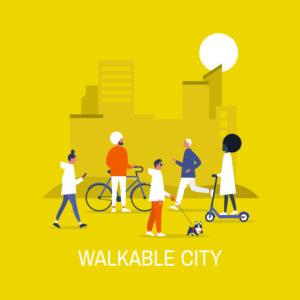Walking Up The Economic Ladder
 Want your kids to have a better life than you do? Move to a more walkable neighborhood.
Want your kids to have a better life than you do? Move to a more walkable neighborhood.
That’s the upshot of a study recently published in American Psychologist. The authors, Shigehiro Oishi, Minkyung Koo, and Nicholas Buttrick, correlated neighborhood walkability with intergenerational upward social mobility. The basic finding: kids who grow up in walkable neighborhoods are more likely to move upward – as compared to their parents – than kids who don’t live in walkable neighborhoods.
The authors begin by noting that “Although upward mobility is generally in decline in the United States …it is easier to get ahead in some parts of the United Sates than in others.” Kids growing up in Pittsburgh, for instance, are much more likely to rise from the bottom 20% (as kids) to the top 20% (as adults) than are kids growing up in Charlotte, North Carolina.
Why would that be? Previous research had identified five factors associated with socioeconomic fluidity for a given area. These are “1) less residential segregation, 2) less income inequality, 3) better primary schools, 4) greater social capital, and 5) greater family stability.” (Social capital is a measure of community participation, including the proportion of people in a given area who vote, volunteer, and otherwise engage in community activities).
Oishi, Koo, and Buttrick accept the “Five Factors” and ask an additional question: does the walkability of a neighborhood also contribute to social fluidity? The authors conducted four different studies to answer this question. Here are some of the top-level findings.
- Comparing 389 commuting zones with walkability ratings from walkscore.com, “showed that upward social mobility was substantially higher in more walkable commuting zones than in less walkable commuting zones.” (r = .390, p<.001)
- But, wait. Maybe it was the Five Factors as opposed to walkability per se. The researchers held the Five Factors constant and found that “walkability explained 11% of additional variance uniquely” beyond the Five Factors. (R2 rose from .41 to .52).
- But, wait. Maybe walkable areas are also more liberal politically – and the liberal policies promote social fluidity as opposed to walkability. Or maybe it’s because walkable areas are healthier and healthier people are more socially fluid. Nope. The researchers held these variables constant (as well as several others). “Overall, walkability was a robust predictor of upward social mobility beyond factors previously used….”
- Why, then would walkability promote social fluidity? One finding is that people have less need for cars in walkable neighborhoods. People without cars can compete effectively for jobs in a wider geographic area.
- Additionally, walkability seems to promote a “sense of belonging” in a neighborhood. The researchers found that these feelings of belonging were “themselves associated with upward social mobility”.
- Does it only work in America? Does this reflect the individualism of America or is it also present in more collectivist societies? The researchers collected data from South Korea, which they describe as a “vertical, collectivist culture”. The finding: “… frequency of walking was indeed associated with a greater sense of belonging, which was in turn associated with upward social mobility.”
This study raises bigger, broader questions as well. Numerous commentators have noted that upward mobility in the United States has declined precipitously over the past 50 to 75 years. Baby boomers may be the last generation to do broadly better than their parents.
This time frame corresponds to the growth of suburbs and our increasing dependence on cars. We can surmise that more people today live in non-walkable areas than they did, say, in 1950. Perhaps this migration explains why upward mobility is declining. As we spread out horizontally, we grow isolated and have less sense of belonging. Though the automobile is a vehicle for geographic mobility, it may well be an obstacle to social mobility.
In the course of writing this article, I discovered a great website: walkscore.com. The site provides walkability ratings on a scale of 0 to 100. For instance, our home in Denver gets a walkability rating of 51. We can walk to some restaurants and are close to some pretty good public transportation. By contrast, our little apartment in Brooklyn gets a walkability score of 99. We could easily live there without a car. Check it out. It may change the way you view your neighborhood.
Decision Theater

In major corporate decisions, a devil’s advocate can serve an invaluable function. The advocate can help stress test an idea and point out cognitive biases that others might miss. The big idea is put on trial. Executives who proposed the idea serve as defense attorneys. The devil’s advocate is essentially the prosecutor. She looks for weaknesses in the other side’s case and serves up an alternative narrative. She also helps the team protect against the down side. The advocate helps us make the decision right — using a balanced process that tends to dampen major biases.
All too often, however, the process devolves into “decision theater”. We’re just playing roles that don’t improve the decision process but do make us feel better about it. Here’s how I’ve seen it play out in various software companies:
- Only a small number of people play the devil’s advocate (DA) role. They do it voluntarily and they get little or no support in terms of resources or even encouragement. Each time we had a meeting about a big decision, the same people spoke up to say, “Well … let me be a devil’s advocate here …” I admired these people but I also wondered, Why do so few people step forward in this role? How could the company promote this role as a regular part of the decision process?
- In these meetings, the devil’s advocate’s objections were always “handled”. In other words, the leader of the meeting (often the CEO) would thank the devil’s advocate for the input and then give a breezy statement that effectively dismissed the input. We all felt better because we had “considered” the other side. But had we really?
- Prior to the meeting, the devil’s advocate had very few resources to develop a coherent position. The DA didn’t have any staff to gather information or budget to hire consultants, etc. The DA’s position might be very thoughtful .. but it wasn’t well developed with evidence to back it up. It could easily be dismissed.
- This is what I call “decision theater.” We believe we’re contributing to a good decision process, but we’re really just acting out roles.
I certainly respect people who play the devil’s advocate role. To make this more than theater however, organizations need to change the process. How? Well, let’s look at the history of the devil’s advocate.
The Catholic church originated the role of the devil’s advocate in 1587. The advocate plays a key role in the process of canonization — determining whether a person should be declared a saint. The process includes a trial, with one side arguing that the person does indeed deserve sainthood. The other side — led by the devil’s advocate — argues the opposite. The devil’s advocate aims to poke holes in the other side’s argument, For instance, the advocate might claim that the miracles attributed to the person were actually frauds.
From my perspective, the most important element was that the church gave the advocate resources and respect to fulfill the role effectively. The devil’s advocate had resources — time, money, staff — to call on. This differs greatly from devil’s advocates in today’s corporate world, who may speak up but are not institutionally supported. A corporation that wants to debias its decision processes should do what the Catholic church did — institutionalize the role and provide enough support to make it serious.
Scanning The Future From Singapore

Can you use a slide rule? The ability to use one effectively could become an important status symbol in the future.
That’s just one idea that I plucked (with a little extrapolation) from Foresight, the biennial scan-the-horizon publication from Singapore’ s Center for Strategic Futures (CSF). Singapore, of course., is a very small country buffeted by giants. CSF describes the country as a “price-taker” – it must accept prices set by other market players.
So how will Singapore survive? That’s the basic question that CSF aims to answer in a series of symposia, structured thought processes, debates, stories, suggestions, conferences, nudges, and “sandboxes”. The idea is to keep ideas about the future top of mind among Singaporean leaders. As CSF says, “Nobody can predict the future, but we can be less surprised by it.”
Since 2012, CSF has published a Foresight document every other year. (Click here for the complete collection). The 2019 edition was published on July 1 and makes for fascinating reading.
CSF uses a structured process based on scenario planning to scan the horizon and create ideas about the future. (For some background on scenario planning, click here, here, and here). CSF calls its approach Scenario Planning Plus, which “retains Scenario Planning as its core, but taps on a broader suite of tools more suitable for the analysis of weak signals, and thinking about black swans and wild cards.” Scenario Planning Plus has six key purposes:
- Defining focus – is the problem simple, complicated, complex, chaotic, or disorderly? (See the Cynefin Problem Framework Definition).
- Environmental Scanning – identify critical emerging issues.
- Sense making – “… piece together a comprehensive and comprehensible picture of an issue.” CSF develops Driving Force Cards to stimulate creative discussions about these issues. (Click here for the current set).
- Develop possible futures – tell stories about what we do, think, and worry about in the future.
- Design strategies – given the various possibilities, how can we best respond to the future?
- Monitor – keep track of indicators, forward signals, and strategies to understand what’s happening and why. (Reading all of CSF’s Foresight documents gives a sense of how our perceptions have changed in just ten short years).
I encourage you to read through the Foresight document and to print out the Driving Force Cards to use in your planning sessions. They’ll stimulate your thinking in both practical and unexpected ways. To give you a sense of what the Foresight document contains, here are some ideas that I found especially interesting:
- Time banking – a marketplace where we exchange time instead of money. Such a marketplace might help us use our time more wisely.
- Heatstroke vaccinations – what if we can’t stop global warming? Maybe we could enhance humans to live in a warmer world. A vaccine against heatstroke would be a good start.
- Cobots – will robots replace humans in most production processes? Or will a combination of humans and robots – cobots – be a better solution?
And why might using a slide rule become a status symbol? When everything goes digital, being able to use analog devices could become a mark of distinction. We already see audiophiles abandoning digital recordings and returning to analog wax discs. Why not slide rules, too?
Finally! A Way To Measure Corporate Culture.

I tell my management students that executives should focus on one task above all others: developing a positive, supportive corporate culture. When a company has a positive culture, all things are possible. When a company has a negative culture, very few positive outcomes occur.
The problem, of course, is how to assess a culture. How does one know if a culture is positive or negative? It’s perhaps the most important question an executive (or job applicant) can ask. But the answer is murky at best. Further, how can one tell if a culture is getting better or worse? Is the company living up to its professed values? How does one know?
A new company called CultureX may help us solve the problem. Formed in conjunction with MIT’s Sloan School of Management, CultureX uses the millions of employee reviews on Glassdoor to analyze corporate cultures. Along the way, CultureX identifies the most frequent values companies profess, the norms used to promote those values, and how employees view company performance in fulfilling the values.
CultureX uses a range of textual analysis tools to analyze free-form employee comments in Glassdoor reviews. The result is a composite view of what it’s like to work in an organization – from employees’ perspective. As you might expect, employee reviews often highlight what the company actually values as opposed to what it professes to value.
CultureX initially applied its methodology to analyze 1.2 million Glassdoor reviews for some 500 companies. The average Culture 500 company has over 2,000 employee reviews. The analysis identified some 60 “… distinct values that companies listed in their corporate values statements.” From the 60, CultureX researchers winnowed the list down to the Big Nine that were cited most frequently. These are: agility, collaboration, customer, diversity, execution, innovation, integrity, performance, and respect.
CultureX researchers then built an interactive tool which “… provides users a snapshot of how frequently and positively employees … speak about each of the Big Nine values.” Users can see how employees discuss each of the Big Nine – even those that a company doesn’t include in its own values statements.
CultureX uses Amazon as an example of how the tool might be used. Amazon’s employee reviews, for instance, spoke frequently and positively about two specific values: innovation and customer centricity. (Innovation was about two standard deviations above the mean; customer centricity was about one standard deviation above). On the other hand, employees were “much less enthusiastic” about the company’s respect for employees – about 1.5 standard deviations below the mean.
How might one use these data? An Amazon executive might be concerned that employees don’t feel respected. The executive might develop programs to improve the company’s performance. (I’m sure that consultants from CultureX would have some suggestions). The executive could then use changes over time in the “respect” value to monitor progress (or lack of it). Similarly, an executive might compare her own company to any number of other companies – in the same industry or in others – to identify competitive gaps and/or advantages.
But the data are not reserved solely for executives. Want to work for a company that is truly innovative? The CultureX data can help you identify which companies are walking the walk and not just talking the talk. Potential employees can identify companies that match their value set. Companies can identify potential employees whose values match the company’s. With better information, both sides stand to benefit.
CultureX’s work should help us focus more attention on the role of corporate culture in business success. The data set could become a useful platform for investors, executives, employees, and job applicants. So … how’s your company doing?
Don’t Argue In The Past Tense
Let’s say that Suellen and I have an argument and I notice that all the verbs are in the past tense. According to Aristotle, the verbs tell us that the argument is about blame. I may think it’s about who left the door unlocked or forgot to pay the mortgage. But it’s really about blame.
Let’s also say that I win that argument. (This is very hypothetical). I’ve successfully pushed the blame away from myself and on to her. It’s not easy to win an argument, so I do a little victory dance. Meanwhile, how does Suellen feel? Probably a mixture of emotions – irritation, annoyance, anger, … perhaps even a desire to get even. Suellen is the woman I love. Why on earth would I want her to feel like that? That’s the problem with arguing in the past tense. Even if you win, you lose.
Arguing in the past tense is generally known as forensic rhetoric. In many legal situations, we do want to lay blame. We want to establish guilt and make sure that the appropriate person is appropriately punished. Most of the testimony in a trial is in the past tense. Similarly, characters in crime dramas speak almost exclusively in the past tense. The goal is to lay blame and Aristotle and others give us rules for how to argue the point.
Outside of the courtroom, however, arguing in the past tense is essentially useless. We can’t do anything about the past. We can’t change it. We can’t enhance it. We can lay blame but, even then, we will argue endlessly about whether we got it right or not. Did we blame the right person? If so, did we blame them for the right reasons? Did we learn the right lessons? Did history teach us anything? Or did it teach us nothing?
The next time you’re in an argument, notice the verbs. If they’re in the past tense, you’re simply trying to blame the other person. Does it do any good to “win” such an argument? Nope. By “winning”, you just give the other side motivation to come back stronger next time. This is how feuds get started. The Stoic philosopher, Epictetus, had it right: “Small-minded people blame others. Average people blame themselves. The wise see all blame as foolishness.”
